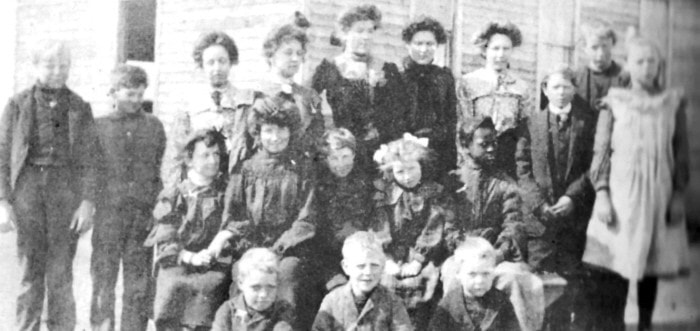By Sandy Alsopp and Mike Rainone
One of the little known but enjoyable tasks for Sandy Alsopp and her summer staff and volunteers at the Fort Ostell Museum is to assist people with the extensive research that will hopefully result in them being able to trace all or part of their colorful family histories in and around the Ponoka district.
Many hours of browsing through old newspapers, books, and photos are required but it can be a great adventure, with many good results, as well as finding countless other amazing stories and artifacts of the long and exciting history and growth of our town and county.
One such request came into the museum this winter and after several months of research, phone calls and letters, an interesting story has come to light about one of our earliest homesteading families. February marked the celebration of Black History Month in Alberta and information had been found about the Thompson family, the first Negro family to settle in our district. Edmond and Hattie Thompson and their little girl, Latechange, arrived here in 1904 and as former slaves from the Kentucky or Louisiana area, they had made the gruelling and dangerous trip to the promise land of Alberta with the assistance of the Underground Railroad, and what a trip that must have been.
Starting back in the early 1800s this secret railway would assist thousands of fugitive slaves to escape to the north and to Canada, with many brave volunteers assisting them along the way in their goal to reach friendly communities and begin a new life of freedom.
Edmond paid the required $10 homestead fees and moved his little family onto a lush quarter section in the Magic District east of Ponoka. As well as having to cultivate 10 to 15 acres each year for three years to maintain clear title, each homesteader was challenged with many other daily tasks, which included the construction of buildings and fences, tending to livestock, planting and harvesting of crops and garden, and chores, while facing the year-round elements and challenges of this new home on the prairies.
The land that the Thompson family settled on had an abundance of trees, which was great for hunting game but also gave Edmond the opportunity to cut and gather huge piles of firewood, which were loaded up and sold around the quickly growing Village of Ponoka. Among the favourite memories of the family was when Latechange was enrolled at the tiny Magic School in 1905 and enjoyed many happy hours of learning and play with girls and boys from the district. The quaint little wooden school was located in the heart of the newly settled Wood River district next to a beautiful parkland lake, which was later called Nelson Lake and remains to this day.
It was during the harsh winter of 1907 that Edmond Thompson had faithfully delivered his wagonload of wood to town but tragically on the way home he encountered a severe blizzard and froze to death. Unable to manage the farm on her own, Hattie had to give up their precious first homestead and moved into Ponoka with her daughter.
Hattie took in laundry to provide the necessities of life for her and her daughter and according to the Canada Census of 1916 they both continued to carry on this task to serve the public for many years in the rapidly growing Town of Ponoka. Latechange later contacted tuberculosis and as was the custom in those early years, patients with this highly contagious disease were admitted into isolation at the Insane Asylum near Ponoka. In 1918 at the age of 24, Latechange died just shortly after giving birth to a daughter, Nellie, who resided for many years in Ponoka with her great-grandmother Hattie. In 1936 they both moved to Edmonton to secure better employment and where the always determined, gritty, and caring Hattie Thompson would live until her death in 1966 at the amazing age of 108 years.
From as far back as the 1880s Negro families began to settle in many communities stretching from western Alberta to the Thunder Bay area, eager to share their heritage and skills with this lush newfound land. Through many ongoing generations they have continued to make countless contributions to all facets of our growth and successes. I vividly recall going to school in the 1950s with Donnie Mays, who was a super athlete, and was raised in a big family that lived along the Battle River.
Alberta’s black pioneer heritage
The first significant black migration into Alberta took place in 1879 with the arrival of the Exodusters from Oklahoma, then in 1910 several families settled in the area. An invitation from the Canadian government offered all American settlers inexpensive land and a more tolerant environment in which to live. Our history books claim that between 1900-01 700 new settler families had arrived in the Ponoka area, including 37 Canadians, 409 Americans, and settlers from other foreign countries. By 1903 the bustling Village of Ponoka had reached a population of 525, and would become Alberta’s newest town in 1904.
John Ware was an ambitious Negro gentleman who arrived in Alberta from Texas in 1882 and would later become one of Alberta’s earliest cowboys. Ware was credited with introducing the rugged breed of Longhorn cattle to the area, and his knowledge and skill with livestock have long been commemorated by the preservation of his first homestead near Brooks, where several natural sites have been named in his honour. Breton is also the home of the only black history museum in Alberta, and features many stories, photos and artifacts highlighting the late 19th century migration of Negro families into what would become Alberta.
